Table of Contents
The personal training consultation is start of your journey with a priospective cllient, it is very important and a good consultation WILL lead to a new cleint. I have used these process for hundreds of consultations with a 90% conversion rate. In fact if I was going to see a new clinet for a consultation I was going assuming they will be a new client.
That might sound a bit confident, but it is important for you to also think like this, you will, in turn, be more confident, one of the most important factors that a client will want to see is that you are confident in yourself, your services and your value.
The process outlined below will help steer your client to engaging with your services, it is so effective that it will not feel like selling, it’s a natural decision for the client at the end of the consultation.
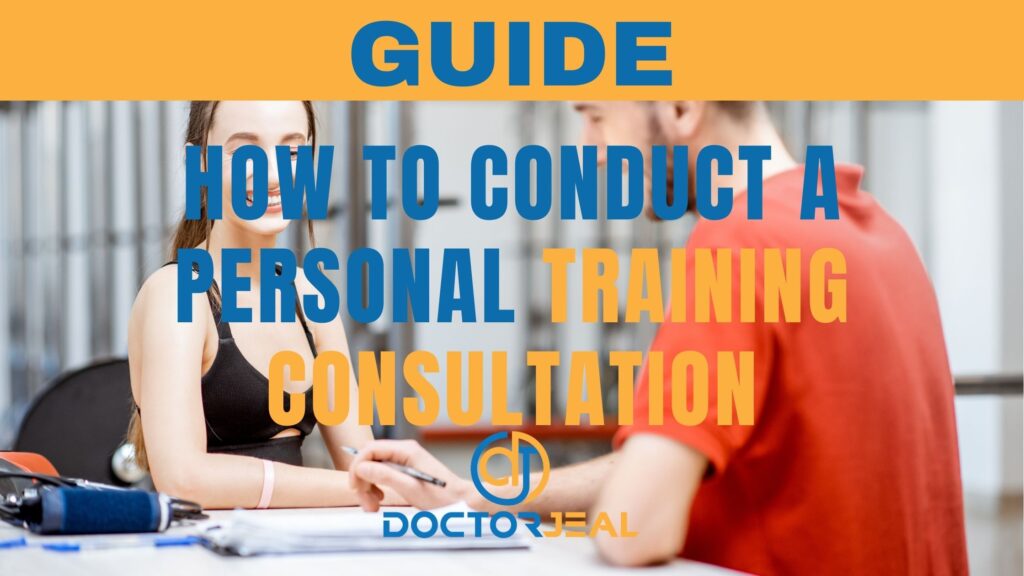
What should the consultation include?
- Medical history check via a PARQ (Pre-Activity Readiness Questionnaire)
- A review of your client’s current lifestyle & eating habits.
- A Health MOT Assessment.
- Goal setting
- Choosing the right personal training package or subscription for you. (if you choose to go ahead, this is NOT a hard sale)
- A signed Informed Consent Form from your client
Introduction
The consultation is the most important part of securing new clients, you’re offering a free service but it should feel like a paid service. You’ll be offering ‘overwhelming-value’, this is providing a professional and comprehensive free service which includes the ‘Health MOT’. Your prospective client will receive A Health MOT regardless if they choose to continue their personal training journey or not.
The whole consultation should last a minimum of 45 minutes yet no more than 90 minutes. You will have to be conscious of the clients time as well as your own.
| As the prospects body fat and body water will be taken during the consultation it’s worth keeping in mind these results will only be fully accurate the assessments should take place about three hours after rising, eating, or hard exercise before taking measurements. While readings taken under other conditions may not have the same absolute values, they are accurate for determining the percentage of change as long as the readings are taken in a consistent manner. |
Aim to collect all personal details from the prospective client from initial contact, the complete the first section of a THE consultation form.
Pre-Consultation
The booking system will handle reminders for the client through their chosen communication method.
“Proper Planning Prevents Poor Performance”
Daniel Jeal
Plan Route to consultation, allow plenty of time to travel to consultation destination & arrive ON-TIME.
Organise documents, forms, clipboards and consultation bag ready to go. using a checklist. Download. a FREE checklist below.
Mobile Personal Training Consultation Checklist 0.00 KB 46 downloads
A simple checklist for checking you have everything you need to conduct a personal…Make sure you have your prospects contact details handy, phone number and address.
The Consultation
MEET & GREET
Knocking on someone’s door you are yet to meet in person can be a daunting prospect as can meeting your client elsewhere perhaps in a public place, coffee shop etc. Rest assured your client will be apprehensive, likely more so than yourself so be confident and make them feel comfortable and relaxed.
Introduce yourself to the prospective client and offer your handshake, be polite and smile. (this is a first impression and they will be judging you)
Have your ID available for inspection if asked.
Be respectful if in clients home, ask if they would like you to take shoes off etc.
ENGAGE & CREATE RAPPORT
Before jumping in and getting the forms out, spend a few minutes talking with the client, at this stage the client may ask you if you would like a drink. This is a great icebreaker and a natural pause before jumping into the consultation. By all means accept if you would like a drink, if not the client will most likely get themselves one to make themselves feel at ease and so join them for a cup of tea, coffee or water is a great way to ease your client into the consultation process.
Ask open ended questions
At this point of the consultation you can engage the client by asking open ended questions that begin with ‘tell me…’, “share with me…” follow with what, how, when, why. here are a couple of examples.
Tell me about your exercise history.
- Share with me a normal day.
- Tell me what prompted you to get a personal trainer.
- Share with me what you’d like to achieve?
Engage in conversation with the emphasis on LISTENING. Don’t write anything down, let the client converse and feel at ease. Let them talk without interrupting them, you’ll be able to extract more information later through specific questions.
It’s a good idea to ask the question about their goal during the rapport stage as you can refer to this throughout the consultation reinforcing why they have requested a consultation.
Confident from the start..
From the start of the consultation talk as if they were already your client, as if there was no question. You might mention what you will do over the first couple of phases, weeks etc depending on your programme design.
for example.
“we’ll be working on ‘x,y’ to get you started and once there we’ll change to ‘z’” Once you’ve completed your food diary, I’ll provide feedback and we can talk through your action plan. Your first phase will build your fitness and we’ll move onto fat burning.
Note: The language here is assumptive! You will be and we will be. As if they are already a client.
START THE CONSULTATION
Explain the consultation process to the client, make them feel at ease and let them know what you plan to do during the consultation. Get your clipboard out with the consultation form, however, although the client would have already seen your consultation bag, avoid getting any testing equipment out until ready to execute that part of the consultation.
PARQ (Pre-Readiness Questionnaire FORM)
PARQ Form (Google Docs Version) 0.00 KB 4339 downloads
PARQ Form Template in Google Docs Version Make a copy to edit your own version. More…The first form you should present to the client is the PARQ form, this is the only form the client will complete themselves, explain as follows
| This is the pre-readiness activity questionnaire, it’s a basic health form. If you could complete your name, address and contact details on the top and then answer yes or no to all questions and give further details if tick yes. |
Once presented, simply let the prospective client complete the form and try not to distract or create dialogue as this will normally always stop the client completing the form. It will only take a couple of minutes, there might be some awkward silence.
Generally most individuals will pass the PARQ however, in the unlikely event the client provides several negative responses to the form, you’ll need to check the back of the PAR-Q form to determine if the client needs to be referred to their GP. Reference document: “PAR-Q – Action Required for Yes Responses.pdf”
Note: Yes responses that require GP clearance does not affect the consultation process, you’ll complete the rest of the consultation as normal.
If the client needs to be referred to a GP
Should this be the case and/or responses to certain health & medical questions on the form suggest they should take advice from their GP before commencing an exercise programme.
Inform to the client they will need to get GP clearance before engaging in a physical activity programme, explain we are not medical professionals and must get GP clearance on any health
related issues that might be worsened or induced by a physical activity programme, this is a necessary step to comply with your personal insurance.
Inform the client you’ll be issuing a letter to give to their GP at the end of the consultation.
At the end of the consultation
The client should be issued with the pre-made letter to their GP. There are two standard letters, one relates to blood pressure and the other to any other question on the PARQ.
At the end of the consultation, give the client the pre-formatted refer to GP letter for either blood pressure or health-related issue, whichever is required. Input the results of the blood pressure test or issue why you have referred the client. The client will need to get the letter Stamped and signed by the GP in order to commence.
Reference document for Blood Pressure:
GP Referral Letter (Blood Pressure) Google Docs Version 0.00 KB 325 downloads
GP Referal letter template to be used by Personal Trainers and Group Exercise instructors…or
Reference document for Health Issue:
GP Referral Letter (General) Google Docs Version 0.00 KB 1329 downloads
GP referral letter template to be used by personal trainers and group exercise instructors…Main Consultation Form Documentation
The following guide will show you how to complete the personal training consultation form available for purchase below.
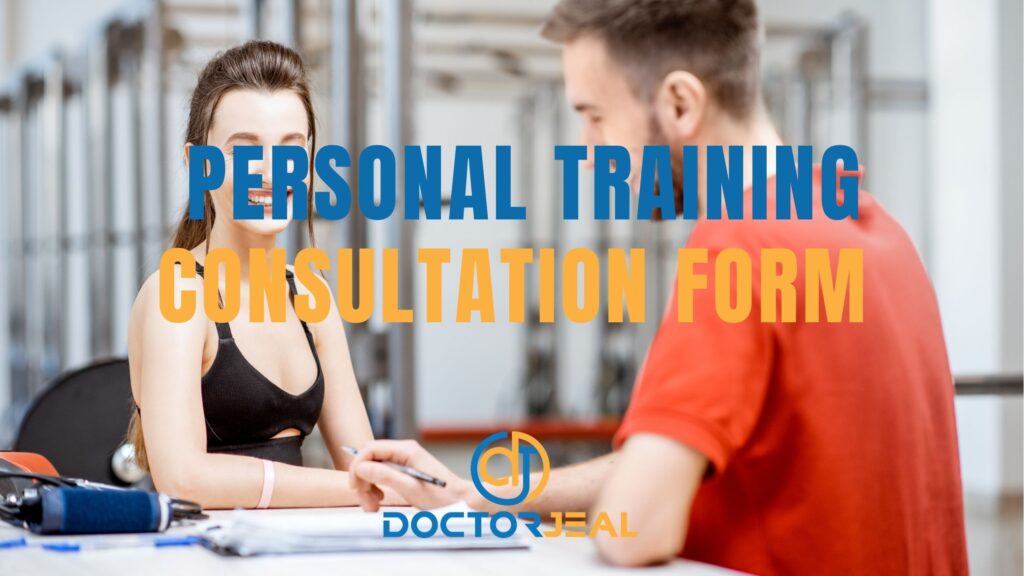
Personal Training Consultation Form
Personal Training Consultation Form Template:
Included file types, PDF and Google Docs
You will now be working through the main consultation form, this is where we will get more information about the clients training background, lifestyle, eating habits and will help you to complete the basic health assessment for the health MOT.
Be natural, don’t read word for word, question for question!
Explain to the client you’ll now be collecting some more information about their exercise history, setting goals and that there will be some basic health assessments at the end of the form.
Use the form as a cue card, if the client has already mentioned something from when you asked open questions earlier, you can now elaborate and get the information down on paper. Imagine you are giving a speech, you want the consultation to flow and not feel like rigid questions, you might know that some question does not apply and therefore don’t ask them. The form is to prompt you to get the data you need to plan an effective programme to the client’s current state of health and fitness.
IMPORTANT: Do NOT give the consultation form to the client to fill out, it will stifle engagement and conversation. You should be the one completing the form!
Consultation Details
Enter the details of the consultation together with the personal details prior to arriving for the client’s consultation, aim to get as much information from the client prior to arrival.
Any details you do not have can be copied over from the Pre-Readiness Activity Questionnaire Form (PARQ) which you’ll get the client o complete prior to starting this consultation form. Note: This does not need to be done at the consultation.

Date
Enter the date of the consultation
Location
Enter the location of the consultation, e.g clients home, Local cafe, park etc
Personal Details

- Name
- Enter the client’s name
- DOB
- Enter the client’s date of birth
- Age
- Calculate clients age
- Gender
- Enter the sex of the client
- Address
- Enter the client’s home address
- Post Code
- Enter the client’s postcode
About Your Training
Have you used a personal trainer before?
Ask the client if they have previously had a personal trainer, either in a gym, or mobile. Circle Yes or No on the consultation form and continue to next question to explore more about their answer if they answered ‘YES’.
If so, when, for how long and did you achieve your goals?
Ask the client if he/she was able to achieve her goals during her last personal training experience, how long did he/she continue training for and what was the reason for stopping.

Are you currently exercising on a regular basis
Thus questions is key to start to understand their lifestyle and exercise habits. This will be a YES/NO answer, if yes continue to ask the following questions.
A common query to these questions is ‘what is regular and what consists of exercise’. In terms of this question, you are looking to see if they currently engage in a structured exercise programme. E.g, attend a gym, running club, sports club etc.
If so, what?
To ascertain the clients present level of fitness, ask what exercise they are currently undertaking on a ‘regular’ basis, such as going to the gym, long walks, a team game, running etc. Write down all activities and frequencies that the client mentions and probe for more accurate information are needed.

Present Fitness Level
With the previous questions in mind, ask the client to rate what they believe their current level of fitness is on a scale from 1 to 5, 1 being very unfit and 5 being very fit. Mark the level and mark half levels if unsure, eg.3.5

Present skill / co-ordination level?
You’ll need to identify the clients skill and coordination level to plan appropriate exercises using proprioceptive skills. Ask the client what they believe their current skill and coordination level is. How likely are they to be able to catch a ball? What s your hand eye co-ordination like?
Rate the the client on a scale from 1 to 5, 1 being very little skill and and 5 being very skilled.

Do you have a preferred training location or area?
Where would the client like to train, record the result and any other relevant information? preferences etc. e.g like to be outdoors!

Have you had any significant areas that might affect exercise?
If the client does indeed have a previous injury or be recovering from an injury or the like then it should have already been noted on the PARQ form. This, however, is a good opportunity to go over the injury and find out more details about movement and exercise restrictions.
If so, what?

What type of exercise do you enjoy?

When asking this question focus on the mode/type of exercise the client prefers and enjoys doing, you’ll want to execute a training plan that the client enjoys. Example include running, free weights, interval training, aerobics class and Zumba etc. Write down all client preferences which should lead you nicely onto the next question what they don’t like!
Which exercises or activity do you particularly dislike?

Are there any exercise or type of exercise that the client does not like, for example they might get bored with running etc.
What equipment do you like or dislike?

As with the type/mode of exercise, we’ll want to know if there is any particular equipment the client either like or dislikes.
Which equipment (if any) do you have available in your home?

This question will help you to plan an appropriate training plan for when you are not with the client as well as saving you bringing unnecessary equipment the client has available.
Health & Lifestyle
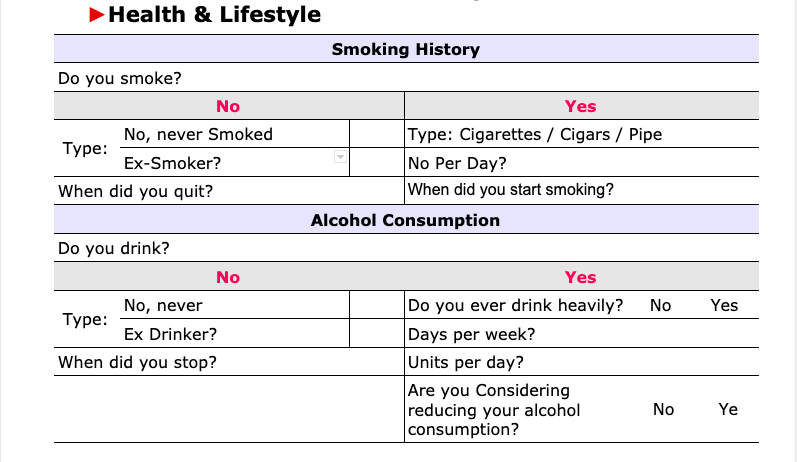
This section of the consultation will identify core habits, it will help you understand what steps need to be taken to break negative habitual activities including excessive drink, smoking and other general activity levels.
Smoking History
Obtain as much information as possible about the client’s smoking habits if any, including dates quit.
Alcohol Consumption
Try to understand the clients drinking habits in terms of units and frequency on a weekly basis.
Which of the following statements most closely describes your feelings?
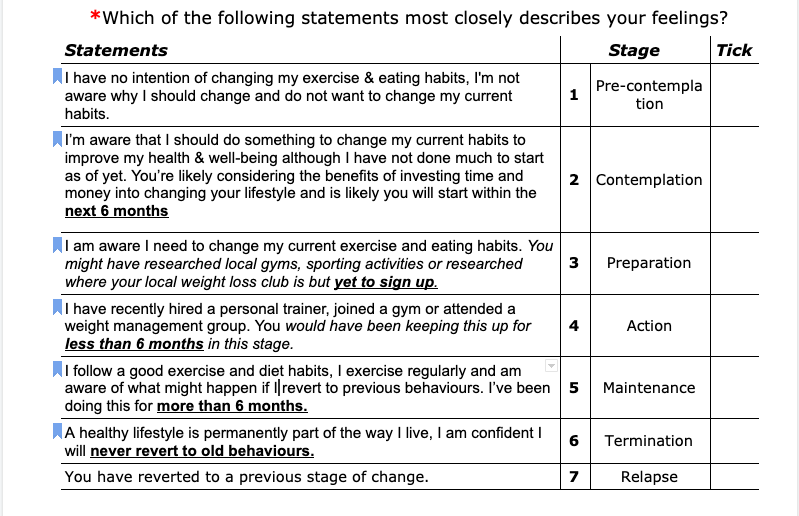
This questions enables us to understand at which stage the client is in the stage of change model, their stage of change is important as it pinpoints their attitude to making behavior habit changes to positively affect their lifestyle.
Avoid reading each question word for word as they’ll likely lose where they are at, instead try to understand the time frame of changes which the stage of change model and the questions below are based upon. They will either have made zero changes (pre-contemplation), be aware although not investigating, intending to within 6 months (Contemplation), be aware and investigating but yet to make a change (Preparation), made a change for less than 6 months (Action), made a permanent change for more than 6 months (Maintenance), permanently changed behaviours (Termination) or if have a drop-off and reverted, they’ll be in relapse.
Therefore talk about the ZERO, NEXT 6, SOON,LESS THAN 6, MORE THAN 6, FOREVER, RELAPSE
I have no intention of changing my exercise & eating habits, I’m not aware why I should change and do not want to change my current habits.
Yes to this question indicates they are in the Precontemplation stage.
I’m aware that I should do something to change my current habits to improve my health & well-being although I have not done much to start as of yet. You’re likely considering the benefits of investing time and money into changing your lifestyle and is likely you will start within the next 6 months.
Yes to this question indicates they are in the Contemplation stage, this is the ‘I WON’T’ or ‘I CAN’T’ stage.
I am aware I need to change my current exercise and eating habits. You might have researched local gyms, sporting activities or researched where your local weight loss club is but yet to sign up.
Yes to this question indicates they are in the Preparation stage, this is the ‘I WILL’ stage (within approximately 30 days)
I have recently hired a personal trainer, joined a gym or attended a weight management group. You would have been keeping this up for less than 6 months in this stage.
Yes to this question indicates they are in the Action stage, this is the ‘I AM’ stage.
I follow a good exercise and diet habits, I exercise regularly and am aware of what might happen if I revert to previous behaviours. I’ve been doing this for more than 6 months.
Yes to this question indicates they are in the Maintenance stage, this is the ‘I HAVE’ stage.
A healthy lifestyle is permanently part of the way I live, I am confident I will never revert to old behaviours.
Yes to this question indicates they are in the Termination stage
You had once started to make changes to your exercise and diet but have since fallen back in old habits. You have reverted to a previous stage of change.
Yes to Question indicates they are in the Relapse stage
How stressed have you been feeling lately?

Get the client to rate of a scale of 1 to 5 how stressed they’ve been feeling recently, 1 is very low and 5 is very high. Also ask what they believe causes the stress, eg. stressful job
What is your employment status?
Understand the clients current employment status which will take you neatly on to the next question.
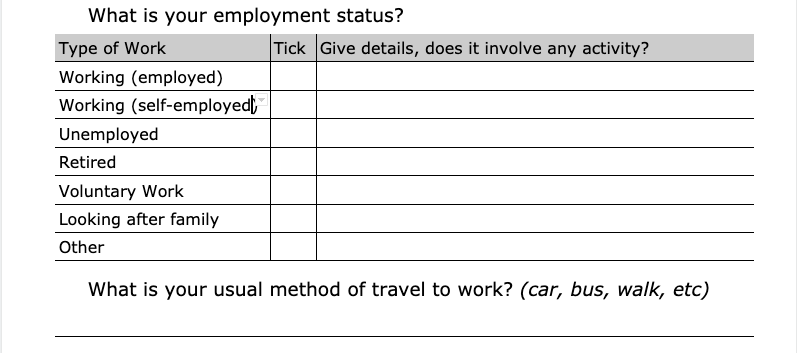
What is your usual method of travel to work?
Understand how the client normally gets to work be it, by car, public transport, cycling or walking etc. Also try to understand how long this normally takes, if it’s an active method take this into account when considering the client’s daily activity level.
How active are you?
This question will estimate how active your prospect is, the answer to this question is required to complete the Kiss Fitness Health MOT. The level indicated is used to calculate the multiplier value to determine Total Daily Energy Expenditure during the day. The options to this question are listed below and within the consultation form.
Rather than reading each statement aloud, ask the following question to draw a picture of their exercise level and intensity and then read aloud the statement you believe is correct and if they believe this represents themselves.
- How many days per week do you exercise?
- How long on average do you exercise on these days?
- What level of intensity do you exercise during these workouts?
The answers to the above question will be enough for you to predict the activity level of the prospect.

You lead a sedentary lifestyle with little to no regular exercise or activity.
Yes to the above question indicates they are in the Sedentary level
You undergo Intensive exercise for at least 20 minutes 1 to 3 times per week. If you do not exercise regularly, but you maintain a busy lifestyle that requires you to walk frequently for long periods, you meet the requirements of this level.
Yes to the above question indicates they are in the Mild Activity level
You undergo Intensive exercise for at least 30 to 60 minutes 3 to 4 times per week.
Yes to the above question indicates they are in the Moderate Activity level
You undergo intensive exercise for 60 minutes or greater 5 to 7 days per week and/or you have a labour-intensive job also.
Yes to the above question indicates they are in the Heavy or (Labour Intensive) Activity level
You are exceedingly active and/or very participate in demanding activities
Yes to the above question indicates they are in the Extreme level Page 9
Describe your leisure time activities and hobbies
Understand how the prospect spends their ‘leisure time’ that is; any time when they are not at paid work. Find out if the client participates in regular hobbies or activities.
This should correlate with the activity level question above, this question will identify the type of activities and.or hobbies the prospect engages in regularly.
About you nutrition
This section will now focus on the clients diet and nutrition, their current eating habits, how they feel about food and any regular habits, good or bad the prospect has.
Do you ever worry that your eating habits could affect your health?
The prospect might well already be conscious about their diet and eating habits although possibility not actively changing their current habits. Understand the prospects concerns if they have any about their current eating habits if they believe they are doing well and eating healthy if they are not too concerned etc.

Which of these statements most closely describes your attitude towards food.
You will now read the following statements out to the client, this will identify the client’s attitude and feeling towards eating. It will help you understand the client’s perspective and will influence how you go about promoting healthy eating as a lifestyle change to the prospect once they become your client.

I enjoy eating but I think I eat too much
I enjoy eating and I think I eat about the right amount
I enjoy eating but don’t think I manage to eat as much as I think I need
I think I eat too much and feel guilty after eating
I don’t eat very much or particularly enjoy eating
How important is it to you to change the way you eat?
This question identifies if even if they are aware of changes that need to be made within the diet if they are concerned enough to want to change and switch to healthy eating as a lifestyle change. Likewise, if the client already has a healthy eating lifestyle they will not likely see a reason to change but back up they view as to why they follow this lifestyle and the benefits for them.

How confident are you in your ability to change the way you eat? Your now asking a direct question about their ability to change, if they do
that they are much more likely to succeed with their goals, if not it will be your job as the personal trainer to promote the reasons why to get them into a stage where they can change by themselves.

Have you ever or are you currently following a diet or eating programme?
Understand if the prospect has previously participated in other diet or eating programmes, these would include weight watchers and slimming world.
If so, what?
Pin down which diets and eating programmes the prospect participated in and how long ago or if indeed they are still following such programmes.

Were diets you used in the past successful?
Continuing from the previous questions find out as to whether the healthy eating programmes and diets if any that the prospect participated in were successful, this is to say they lost their goal weight and kept it off. We will be able to identify if the prospect falls with a YoYo diet lifestyle from the answers to these questions. If the client re-gained the weight, it would be deemed not successful and you’ll find out why in the next question.
Why?
Find out why the healthy eating programmes or diets were successful or not and why they think that was the case.

Take me through a typical day
This is an excellent flow question, you’ll guide the prospect to take you through a typical day, you will want to find out what time they rise, have breakfast, snacks during the day and main meals, times are important so try to pin the prospect down with these.
We will start to be able to understand the clients eating habits from this question providing they have given an accurate representation of the day.
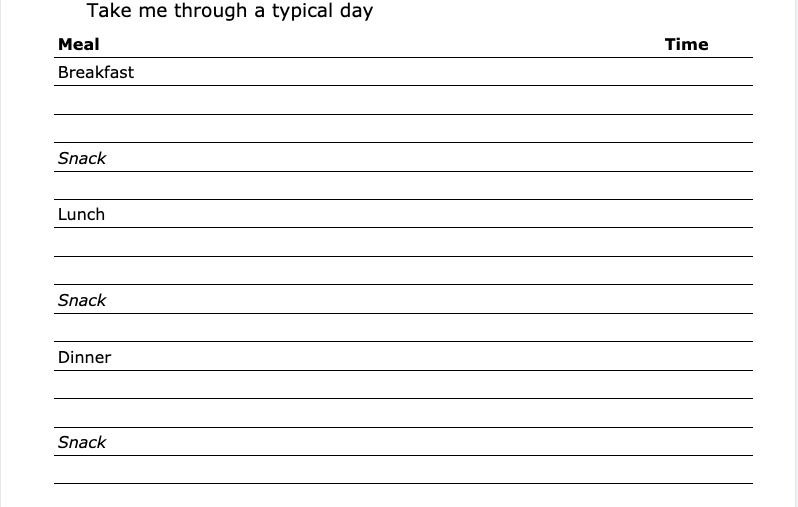
Goal Setting
The goal-setting process in the consultation is very important, it’s essential in being able to plan a suitable and effective programme for your prospective client. It’s your job via the process below to shape what the prospect wants into an achievable and realistic time-framed goal.
What is your ultimate goal from this health & fitness programme?
Ask the client what their ultimate goal is from this training plan? what is it they want to achieve, look like or be able to do? We will use the S.M.A.R.T acronym adapted for use in planning health & fitness goals to set appropriate goals.
Complete each section of the S.M.A.R.T acronym on the consultation form.
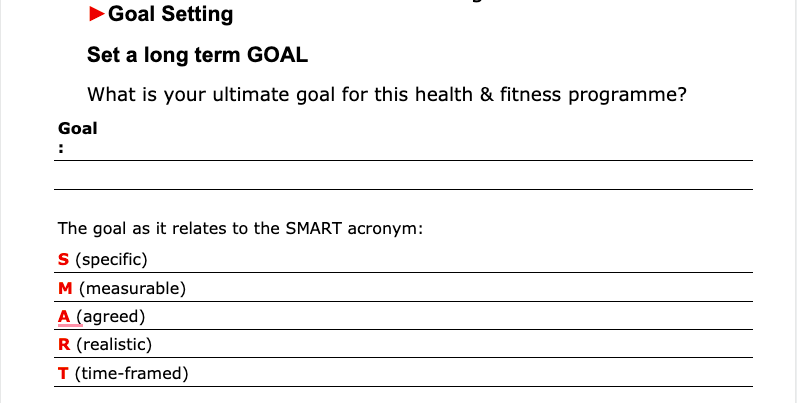
The goal as it relates to the SMART acronym: Specific, Measurable, Achievable, Realistic, Time-Framed
S = Specific
A goal must relate to one outcome or process that the client wishes to achieve.
e.g. To run a half marathon in under two hours on 1st October.
M = Measurable
There must be a way to tell if the client has been successful in reaching their goal, fitness assessments or questionnaires may be used for this purpose
e.g. Periodically measure running performance with a submaximal VO2 assessment on the treadmill. The ultimate measurement of achievement will be the marathon itself.
A = Agreed
The goal must be something desired by the client that you can agree is ethical and will not have an adverse effect on their physical or
psychological well-being, it is also important that you agree the goal can be achieved in the given timeframe.
e.g.The client has expressed this goal as the desired achievement and the trainer has committed to helping them achieve this goal. A written contract has been signed to agree and commit to this goal.
R = Realistic
Based on the client’s current health and fitness status, lifestyle barriers. ability and motivation to change, is it possible for them to achieve the goal in the given timeframe.
e.g. The client already runs 5km comfortably and has allowed a four-month timeframe in which to achieve this goal. They are committed and very motivated to begin training.
T = Time Framed
A goal must have a fixed time within which it is to be achieved or it becomes easy to procrastinate and hard to stay motivated.
e.g. The timeframe for this goal ifs four months. The Half marathon takes place on 1st October.
Set a short or medium term goal
Set a short or medium-term goal, this could be related to the ultimate goal or something different than the client would also like to achieve on their journey towards their ultimate goal.
Once again, outline the goal by applying the S.M.A.R.T acronym.
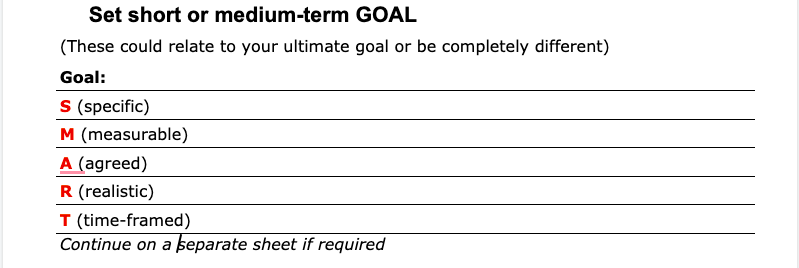
Why are these goals important to you?
Identify the reasons why the client believes the set goals are important to them.
How will you feel when you achieve the goals you have identified?
At this point we are trying to get the client to imagine achieving the goal they’ve just set, often it helps to get the client to imagine themselves at the end of their goal and asking them how they would feel if all the goals set had been achieved by that time.
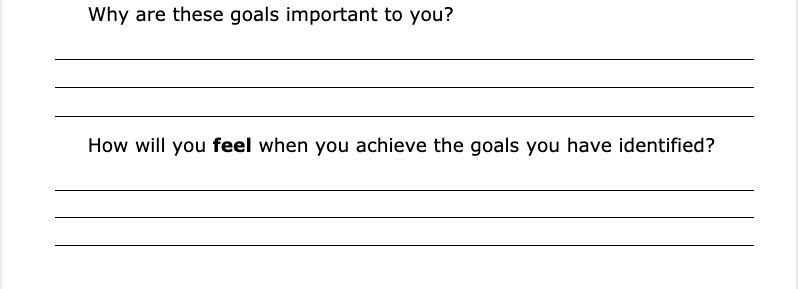
What are the barriers or challenges to achieving your set goals?
Are there any barriers that might affect the ability of the prospective client to achieve their goals set out? This could be time constraints, childcare, motivation to exercise, self-discipline etc.

How do you think you could overcome these barriers & challenges?
Now you’ll need to find ways to overcome the mention barriers from the previous section. e.g. motivation? You’ll be able to motivate the prospective client to exercise with constant positive reinforcement, tracking and accountability. It’s unlikely with a personal trainer this will now be a barrier.

Health Screening & Assessments (Health MOT)
This section of the consultation form is where you will perform all the health assessment tests. These will help produce the FREE Kiss Fitness MOT for the prospective client. This report is produced using the Kiss Fitness Health MOT Tool available online.
Body Composition
The first section of the health assessment is body composition, these includes, height, weight, body fat & body water.

Height Measurement
You’ll need to know the prospective clients height to execute the remainder of the assessment so take this first.
Equipment: Height measurement tool
Testing procedure:
- The measuring tape is to be fixed on a flat wall at two metres above the floor. The floor should ideally be a hard surface (preferably, not carpet).
- The client is to be measured in socks or bare feet.
- The client stands with their back to the wall and feet together with the heels, buttocks and shoulders touching the vertical plane. The head when placed in the ‘Frankfort’ plane need not be touching the wall. The ‘Frankfort’ plane is achieved when the orbitale (lower edge of the eye Socket) is in the same horizontal plane as the tragion (the notch superior to the tragus of the ear). When aligned the vertex is the highest point on the skull.
- The subject is asked to take and hold a deep breath.
- Lower the height measuring device to make contact with the subject’s scalp, crushing the hair. Read and record the height in metres to the nearest whole centimetre.
NB: Different postural positions combined with the effects of gravity on the compression of the spine can have a significant impact on the height measured. Compression of the spine by gravity can reduce height by up to 1%. By following the set procedure variables such as time of day and inter and intra-tester variability are minimised thus reducing survey error.
Weight Measurement
The weight is taken using the Tanita BF-522W Body Fat Scales, the scales will require the prospective clients age and height to produce a body fat and body water reading. Follow the procedure below to accurate record these readings.
Equipment: Tanita BF-522W Body Fat Monitor / Scale
In conjunction with these procedures please ensure you fully read the operation manual for these scales in order to provide accurate and consistent readings for your client.
GETTING ACCURATE READINGS
To ensure accuracy, readings should be taken with minimal clothing and under consistent conditions of hydration. The prospective client’s stockings or socks will need to be removed as their bare feet need to be in contact with the scales, be sure the soles of the feet are clean before stepping on the measuring platform.
Be sure that your heels are correctly aligned with the electrodes on the measuring platform. Don’t worry if your feet appear too large for the unit – accurate readings can still be obtained if your toes overhang the platform.
It is best to take readings at the same time of day. Try to wait about three hours after rising, eating, or hard exercise before taking
measurements. While readings taken under other conditions may not have the same absolute values, they are accurate for determining the percentage of change as long as the readings are taken in a consistent manner. To monitor progress, compare weight and body fat percentage taken under the same conditions over a period of time.
Note: An accurate reading will not be possible if the client’s soles of their feet are not clean, or if their knees are bent or they are in a sitting position.
Body Fat Percentage
The Body Fat Percentage Reading is the second reading displayed on the Tanita Body Fat Scales Display. Record this reading on the consultation form.
Total Body Water Percentage
The Total Body Water Percentage is the third reading displayed on the Tanita Body Fat Scales. Record this reading on the consultation form.
Blood Pressure

Equipment: Automatic blood pressure Monitor
Testing Procedure:
- Seat the subject comfortably in a chair. Wrap the cuff around the upper left arm with the edge of the cuff approximately 1 inch above the elbow. When wrapping the cuff, wrap it loosely enough around the arm so that two fingers can be placed between the cuff and the arm. If the cuff is wrapped more tightly or loosely than this, inaccurate blood pressure readings may result. If the shirt sleeve is rolled up over the upper arm, ensure that it not constricting the blood flow as this will produce an inaccurate measurement.
- Press the ON/OFF button to switch on, the cuff will automatically start to inflate, the blood pressure machine will automatically stop when it gets to the correct level of inflation and begin to deflate, you will hear beeps that will sync with the prospects heart rate dropping until a reading is displayed on the screen.
NB: When testing in a workplace environment it is important to consider factors which may have an adverse impact upon the result of the test. Stress, anxiety and nervousness can all increase blood pressure and it is not unusual for subjects to report these symptoms. An unusually high daily workload or anxiety about having a blood pressure taken can elevate blood pressure levels. Therefore it is important to re-test subjects who report high readings having given them a few minutes to relax.
1st Blood Pressure Reading
Following the above procedure, record the prospects readings on the consultation form.
● Systolic (Required for Health MOT)
● Diastolic (Required for Health MOT)
● Resting Heart Rate (RHR) (Required for Health MOT)
2nd Blood Pressure Reading
Often especially if the client is prone to ‘white coat syndrome’ that is, increased heart rate by the fact they know its about to be taken. A second and third reading to obtain an average will be useful. It will also be required if the client has high blood pressure in the first reading. If so wait 5 minutes to allow the heart rate to settle down and re-test recording the results.
3rd Blood Pressure Reading
Record the result for a 3rd test if required through initially high blood pressure readings.
see also Blood Pressure Monitoring and Testing
Peak Flow Reading
The Peak flow test is used primarily to monitor progression or regression in sufferers of asthma, however, as a means of measuring how well air is moving through the airways in the lungs, it enables us to track the effects of exercise on our clients.

There are several types of Peak Flow Meters available representing different scales, for the Health MOT and the client’s consultation we strongly advise using the
Mini-Wright (Standard Range) EU (EN 23747) scale.
This meter is distinguished with the yellow scale on the side of the meter. If you use any other scale you will need to convert the reading to the EU scale to input the results in the Health MOT Calculation Form.
Testing Procedure:
- Insert a new disposable mouthpiece into the meter.
- Ensure the pointer is set to zero (L/MIN position).
- Instruct the prospect to hold the Peak Flow meter so that their fingers are clear of the scale and slot. Remind the client not to obstruct the holes at the end of the Peak
Flow Meter
- If possible instruct the client to stand up
- Take a deep breath, place the Peak Flowmeter in the mouth and hold horizontally closing the lips around the mouthpiece, then blow as hard and as fast as you can.
Please note that any coughing or spitting into the meter will adversely affect the prospects readings and should be avoided.
- Note the number on the scale indicated by the pointer and record on the consultation form.
- Take two further readings to get an accurate average result.
Anthropometric Measurements
Anthropometry is the study of dimension, mass and proportion of the human body. In its simplest form anthropometry, it’s represented by a measure.

General Procedures
- The tape should be placed to the long axis of the body part to be measured
- The tape measure should be pulled to the correct tension around the limb/body part without pinching the skin
- Duplicate measurements should be taken at all sites and should be re-tested if measurements do not fall within 7 mm or 0.25 inches.
Chest
This measure is taken at the level of the middle of the sternum (breast-bone), with the tape passing under the arms. After the tape is in position, the arms should be relaxed by the side, and the measurement taken at the end of a normal expiration. When recording, you need to make sure the tape is not too tight or too loose, is lying flat on the skin, and is horizontal, particularly around the back.
Abdomen
The measurement is taken with the subject standing relaxed and is a horizontal measure taken at the level of the umbilicus.
Waist
Measure the waist girth at the midway point between the lowest rib and the top of the iliac crest (hip bone) and record in centimetres.
Hips
The measurement is taken with the subject standing upright and naturally and is a horizontal measure taken at the level of the maximum circumference of the hips and buttocks.
Shoulders
The measurement is taken as the distance between the lateral borders of the acromion processes (the two bones at the ends of the shoulders)
Arms, left & right
The measurement is taken with the subject’s arm extended to the side of the body, perpendicular to the body. It is a horizontal measurement taken midway between the acromion and olecranon processes.
Thighs, left & right
The measurement is taken with the subject’s legs slightly apart. It is a horizontal measurement taken at the maximum circumference, just below the gluteal fold.
Forearm, left & right
The measurement is taken with the subject standing upright, arms hanging downward, but slightly away from the trunk and with palms facing forward. The measure is taken perpendicular to the long axis of the forearm at the level of the maximum circumference.
Calf, left & right
The measurement is taken with the subject standing upright. It is a horizontal measurement taken at the maximum circumference between the knee and the ankle.
Neck – RARELY REQUIRED TO BE TAKEN
The neck measurement is taken immediately above the thyroid cartilage (the Adam’s Apple). The subject should keep their head up and look straight ahead. When recording, you need to make sure the tape is not too tight or too loose, is
Posture
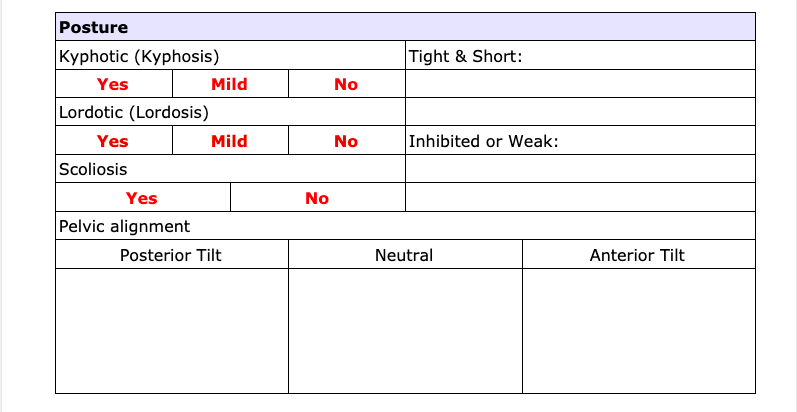
Kyphotic
Lordotic
Scoliosis
Pelvic Alignment
Tight & Short
Inhibited or weak
This concludes the fitness assessments for the consultation and Health MOT.
Fitness Assessments
In this section you will identify fitness assessments that will be relevant to assessing the progress of your client, it could simply be their weight and body measurements or include more advanced testing such as lactate threshold, vo2max via a multistage fitness test or strength test such as a 1 minute push up test.
This is not a question you will ask the client but something you will write down and discuss with the client about how you will test their progress to their chosen goal.
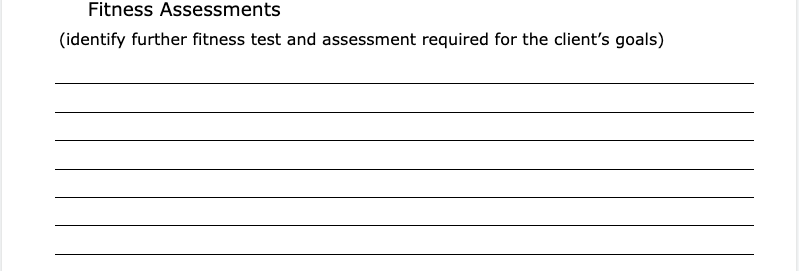
Client Photo
As a means of self-motivation for the prospect and tracking progress, you’ll ask the client if they mind having a photo taken.
Does the client mind having a photo taken?
Inform the prospect they can be just private for personal tracking or if they would mind using them for marketing in a public domain.

Marketing Information
Where or how did you hear about us

Ending the Consultation
Is there anything you would like to ask me or have any other questions?
At this point in the consultation, you have asked most of the questions and now you’ll let the client ask any questions they might have for you. They might ask about the training.

The Close
Suggested Frequency & Pricing Options
At this stage, the consultation is coming to an end and the client will be looking to find about prices and packages. The aim of this section is to understand how many sessions is both achievable in terms of time and budget and suitable for them to achieve their goals if the client has not already purchased a series of Personal Training it’s now time to sell your services to the client.
Often a good way to start this conversation is to ask the prospect;
How many sessions did you think you might want?
This an ambiguous question and they probably won’t automatically know but likely will come up with a rough idea, this is key as it will represent what they are likely to accept as a package.
You want the client to be happy, if you have explained the benefits of personal training and executed the consultation professionally and as described here, you should have built up a relationship and built value in yourself, you’ve identified their goals, they’ve imagined and seen themselves achieving them. They will be ready to sign up. This part should not be confrontational, or a hard sell.
Optimal sessions will be different for each client, you should propose what you recommend in order to get the results within the selected time frame however be patient and adaptable to clients budget constraints.
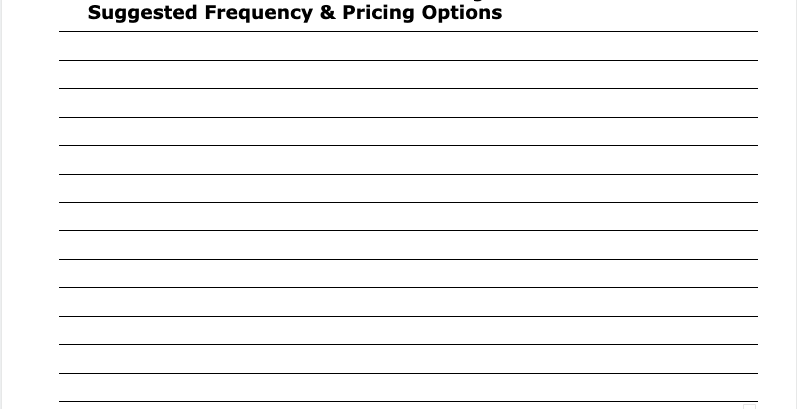
Example
“for your current fitness level and background I’d recommend 3 sessions per week to get you to your goal in 3 months”. Most people would benefit from 3 sessions per week if they could afford it, the constraints here will be time & money.
Don’t force them into a higher frequency option they can not afford and don’t make them feel bad about not being able to afford 3 sessions per week.
If they can only afford 1 session per week, explain that you will design the training programme to accommodate that.
If you set the client up paying for something they can not afford, they will not stay long regardless how good the service is and vice versa if you get it just right they
Did the prospective client convert?
The last section is for marketing purposes however you should fill out what you can, including sessions purchased and type of package.
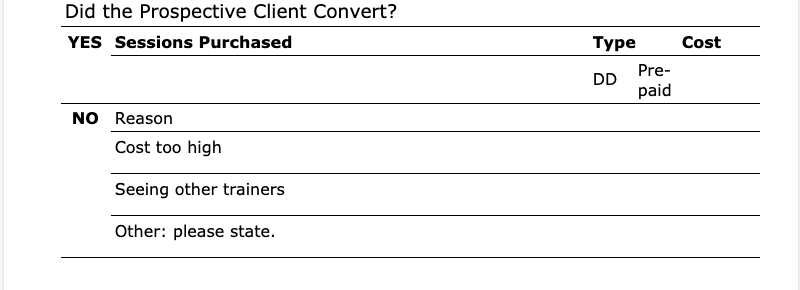
Thank You – Finishing Up
Thank the client for their time and let them know you’ll bring their Health MOT Report to their first session or alternatively will email of they choose not to continue with personal training.

